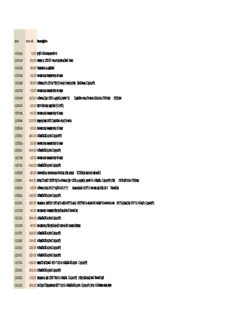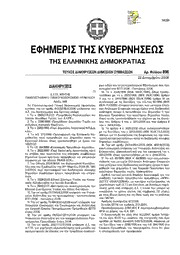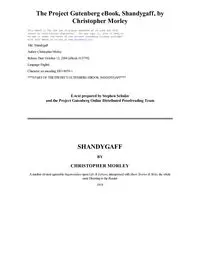
A parallel approach to bi-objective integer programming PDF
Preview A parallel approach to bi-objective integer programming
A parallel approach to bi-objective integer programming W. Pettersson 7 School of Science, RMIT University, 1 Victoria 3000, Australia. 0 2 william@ewpettersson.se n M. Ozlen a J School of Science, RMIT University, 1 Victoria 3000, Australia. 3 melih.ozlen@rmit.edu.au ] C 16 January 2017 O . h Abstract t a m Toobtainabetterunderstandingofthetrade-offsbetweenvariousob- jectives, Bi-Objective Integer Programming (BOIP) algorithms calculate [ the set of all non-dominated vectors and present these as the solution to 1 a BOIP problem. Historically, these algorithms have been compared in v terms of the number of single-objective IPs solved and total CPU time 0 taken to produce the solution to a problem. This is equitable, as re- 2 searchers can often haveaccess towidely differingamounts of computing 9 power. However,therealworldhasrecentlyseenalarge uptakeofmulti- 8 core processors in computers, laptops, tablets and even mobile phones. 0 With this in mind, we look at how to best utilise parallel processing to . 1 improve the elapsed time of optimisation algorithms. We present two 0 methodsofparallelising therecursivealgorithm presentedbyOzlen,Bur- 7 ton and MacRae. Both new methods utilise two threads and improve 1 running times. One of the new methods, the Meeting algorithm, halves : v runningtimetoachievenear-perfectparallelisation. Theresultsarecom- i paredwiththeefficiencyofparallelisationwithinthecommercialIPsolver X IBMILOGCPLEX,andthenewmethodsarebothshowntoperformbet- r ter. a 1 Introduction Integer Programming (IP) requires either one single measurable objective, or a pre-existing and knownmathematical relationshipbetween multiple objectives. If such a relationship, often called a “utility function”, is known then one can optimise this utility function (see e.g.,[1,4]). However,if the utility function is unknown, we instead identify the complete set of non-dominated solutions for the Bi-Objective Integer Programming(BOIP) problem. The net result is that 1 a decision maker can more easily see the trade-offs between different options, and therefore make a well informed decision. Algorithms that determine this complete set can take exact approaches [2], or utilise evolutionary techniques [7]. For further details on multi objective optimisation see [3]. The performance of BOIP algorithms, and algorithms in general, is often based on the CPU time taken to find the solution. This does allow algorithms tobecomparedwithoutneedingtouseexpensiveorspecialityhardware(aslong as comparisons are made on identical hardware setups), but does not take into account real world computing scenarios. Recent times have seen desktops and laptops move completely to hardware with multiple computing cores. Given this, we look at how to best utilise parallel processing in BOIP algorithms. We constrainourselvestobiobjectiveproblemstodemonstratethefeasibilityofour approach. Inthis paperwelookataBOIPalgorithmfromOzlen,BurtonandMacRae [5] which calculates a solution by recursively solving constrained IPs. This algorithm uses IBM ILOG CPLEX to solve all constrained IPs. As CPLEX does include it’s own parallelisation code, we give results on the effectiveness of parallelisation within CPLEX. We also demonstrate our own approach to parallelisation of the recursive algorithm of Ozlen, Burton and MacRae. Our new parallelalgorithmachievesnear-idealparallelisation,calculatinga solution in half the running time without incurring any additional computational time. This proves far more effective than parallelisation within CPLEX. Section2ofthis papergivesabackgroundinoptimisation. Section3givesa briefoutlineoftherecursivealgorithmwebuildupon. Section4containsdetails of our parallel computing approach. Section 5 details our software implemen- tation and gives running time comparisons between the original algorithm, the original algorithm with CPLEX parallelisation, and our parallelisations. 2 Background In an integer programming (IP) problem, we are given a set of variables and a set of linear inequalities called constraints. An assignment of an integer value toeachvariableiscalledfeasibleifitsatisfiesallconstraints,andanassignment which does not satisfy all constraints is called infeasible. The set of all feasible vectors we will call the feasible set, and can be defined as follows. Definition 1. The feasible set of an IP problem is given by X ={x∈Zn|Ax=b,x ≥0 for j ∈{0,1,...,n−1}} j where A is an n-by-n matrix and b is an n-by-1 matrix that together represent the linear constraints of the problem. Note that inequalities can be converted to equalities with the introduction of slack variables (see e.g. [6] or any introductory linear programming text). Given a feasible set X and an objective function f, the goal of an IP is to find the solution x ∈ X that optimises f(x). In this paper we assume that all objective functions are to be minimised. In some scenarios the goal is to maximise a givenobjective function. Such a problemcan trivially be converted 2 into an equivalent problem where the objective is to be minimised. We will denote an IP (and various derived problems) with P. Inamultiobjectiveintegerprogrammingproblem,wedonothaveonesingle objective function but rather a set of objective functions. The goal then is to determine all non-dominated (or Pareto optimal) solutions. Definition 2. Given a pair f ,f of objective functions f :X →R, a solution 1 2 i x∈X is considered non-dominated (or Pareto optimal) if there does not exist an x′ ∈X with x′ 6=x such that f (x′)≤f (x) for all i∈{1,2}. i i A bi-objective integer programming problem then involves the calculation of the set of all non-dominated feasible solutions. Given a set of objective functions, one of the simpler methods of generating a related single-objective IP is to apply an ordering to the objective functions, and compare solution vectors by considering each objective in order. That is, each objective function is considered in turn, with objective functions that appear earlier in the ordering being given a high priority. We will call such a problem a lexicographic bi-objective integer programming (LBOIP) problem on k objectives. Our parallelalgorithmwill use different orderingsof a set of objective func- tions to determine the solution set. To aid readability, we therefore introduce the following notation to refer to different lexicographic variants of a BOIP problem with a given set of objectives. Notation 1. If a lexicographic version of the BOIP P will order objectives according to the ordered set (f ,f ), we will write P(1,2). 1 2 The optimal solution for a LBOIP will be part of the solution set for the relatedBOIP,but there is no guaranteethat it will be the only solution for the BOIP. Indeed, it will often not be the only non-dominated solution. To deter- mine all non-dominated solutions, the algorithm described in Section 3 utilises constrained lexicographic multi bi-objective linear programming (CLBOIP). A CLBOIP is simply a LBOIP with a constraint on the last objective function. These constraints limit the solution space to some given bound. Notation 2. Given an LBOIP Ps, if the upper bound on the final objective is l we will denote the CLBOIP by Ps(<l ). k k s Recall that P denotes that the ordering of the objectives is given by the permutation s, which will be an element of the symmetric group S for our 2 biobjective problems. 3 The algorithm of Ozlen, Burton and MacRae The full recursive algorithm as given by Ozlen, Burton and MacRae is suitable for problems with an arbitrary number of objective functions. Here we give a brief outline ofa biobjective versionof the algorithm. For a complete introduc- tiontothealgorithm,see[5]. GivenabiobjectiveIPproblemwithtwoobjective 3 functions f and f , the algorithm runs as follows: 1 2 Data: A BOIP P with objective functions f and f 1 2 Result: The non-dominated solutions to the BOIP Let S ={} be an empty set to which we will add all non-dominated solutions; Let l =∞; 2 while P(1,2)(<l ) is feasible do 2 Let x=(x ,x ) be the optimal vector for the CLBOIP P(1,2)(<l ); 1 2 2 Add x to S; Set l =x ; 2 2 end Algorithm 1: A simple overview of the biobjective version of the algorithm from Ozlen, Burton and MacRae. Thecorrectnessofthisalgorithmisreadilyshownbyinduction. Foraformal proof of the correctness of this algorithm, see [5]. 4 Parallelisation Comparisons of algorithms are often based on either the number of single- objective IPs solved, or CPU time taken to solve the problem. In the real world, the only thing that really matters (for correct algorithms) is the time between describing the scenario and receiving the solution. Not everyone will haveaccesstosupercomputingfacilities,howeverdesktopandlaptopcomputers have had multiple cores as standard for many years now. We therefore look to reduce the elapsed running time of optimisation algo- rithms by introducing parallelisation. We will use the term thread to denote a single computational core performing a sequence of calculations. In a parallel algorithm, we therefore have multiple threads which are performing multiple calculations simultaneously. In this paper we look at improvements gained by utilising two threads at once. 4.1 Range splitting When solving P, it is clear that the maximum and minimum values of f (x) 1 canbedeterminedbysolvingtwoLBOIPproblemsP(1,2) andP(2,1). Onena¨ıve methodofdistributingthisproblemacrosstthreadswouldbetosplitthisrange into t equal sized pieces, and then adding an upper and lower bounds on f to 1 the specific sub-problem solved by each thread. These results can be combined intheobviousmannertogivethesolution. Wewillrefertothisalgorithmasthe Splittingalgorithm,astherangeoff issplitupsothateachthreadgetsasingle 1 section. The proof of correctness of this algorithm is trivial. Implementation and timing results are detailed in Section 5. 4.2 Efficient parallelisation Whilst the algorithm discussed in the previous section is parallel, there is no guaranteethatallthreadswillperformanequal(ornear-equal)amountofwork. Indeed, it is easy to visualise problems where one thread will perform far more 4 workthananother. Insteadweuseanalgorithmwhichdynamicallyadaptsitself as the solution set is found. Recall that in Algorithm 1 we used the specific ordering P(1,2). We could also solve P(2,1) and obtain the same result. This idea forms the basis of our work. We show below how the limit l obtained from P(1,2)(<l ) is able to be 2 2 sharedwiththeproblemP(2,1)(<l ). Thisallowsthetwoproblemstobesolved 1 simultaneously,whichalmosthalvestherunningtimeofournewalgorithmwhen compared to the original. Theorem 1. If we have the complete set S of non-dominated solutions for P(1,2) with x ≥ k, the complete set S′ of non-dominated solutions for P(2,1) 2 with x ≥l, and we also have the non-dominated solution (l,k), then the union 1 SSS′S{(l,k)} is the complete set of non-dominated solutions to P. Proof. Assume that x = (x ,x ) is a non-dominated solution to P that is not 1 2 in either S nor S′. If x > l then x ∈ S′, a contradiction. Similarly, if x > k 1 2 then x ∈ S which is also a contradiction. Therefore x ≤ l and x ≤ k, but 1 2 then as (l,k) is non-dominated, the only solution is (x ,x )=(l,k). 1 2 Note that P(1,2) and P(2,1) are both CLBOIP problems that can be solved independentlybyAlgorithm1,andthat(l,k)willbefoundasasolutiontoboth oftheseproblems. Giventhisresult,weproposethefollowingparallelalgorithm for computing the solution to BOIP problems. Data: A BOIP P with objective functions f and f 1 2 Result: The non-dominated solutions to the BOIP Let t∈{1,2},and let t′ be the unique value in {1,2}\{t}; Let s =(2,1) and s =(1,2); 1 2 Let S =S ={} be empty sets; 1 2 Let l =l =∞; 1 2 foreach thread t do while Pst(<l ) is feasible do t Let x=(x ,x ) be the solution for the CLBOIP Pst(<l ); 1 2 t Add x to S ; t Set l =x *; t t Add xt′ <lt′ as a constraint to Pst(<lt) *; end end return S ∪S 1 2 Algorithm 2: A parallel version of the algorithm from [5]. Note that in the lines marked *, the values lt and lt′ are shared between the two threads. We call this algorithm the Meeting algorithm, as the two threads meet in the middle to complete the calculations. Correctness of the Meeting algorithm follows from Theorem 1 and the correctness of Algorithm 1. 5 Implementations and running times 5.1 Implementation Our algorithms were implemented in C++, and are available at https://github.com/WPettersson/moip_aira. All calculations were run on 5 Assignment problems # tasks Ozlen et al. CPLEX Splitting Meeting 40 10.95 11.00 9.14 5.74 60 34.42 31.89 28.74 17.83 80 68.39 57.55 55.57 35.63 100 118.69 106.30 95.66 63.37 200 515.57 453.54 402.98 276.90 500 3262.26 3468.03 2327.63 1738.74 Knapsack problems # items Ozlen et al. CPLEX Splitting Meeting 50 1.00 1.10 0.67 0.53 100 5.03 4.83 3.60 2.59 200 22.37 20.56 16.13 11.53 400 73.75 71.69 57.70 36.42 1000 338.67 347.34 263.01 150.06 2000 1200.50 1113.11 912.85 528.85 Table 1: Elapsed running timing comparisons of the four algorithms. We ran ten different random versions of each sized problem and averagedthe results. the NCI supercomputing cluster Raijin, on nodes consisting of two Intel Sandy BridgeE52670processorsand32GBofRAM.CodewascompiledwithGCC4.9, using no special optimisation controls beyond -O2. We compared the elapsed runningtime(andnotcomputationaltime)oftheoriginalalgorithm(withboth one thread allocated to CPLEX, and two threads allocated to CPLEX), along with the Splitting algorithm and the Meeting algorithm. These running times are summarised in Table 1. From the table, we see that letting CPLEX use a second thread improved runningtimesonlyslightly. ItisnotsurprisingthatCPLEXdoesnotparallelise efficiently in this manner, as CPLEX cannot take advantage of the full details of the algorithm used. The Splitting algorithm was more impressive, showing significant results. However, our Meeting algorithm is the clear outlier, twice as fast as the original algorithm of Ozlen, Burton and MacRae on all problems. This is the ideal outcome for parallelising the algorithm with two threads. 6 Conclusion We successfully implemented two parallel algorithms to solve biobjective op- timisation problems. Both improved performance, with one showin ideal per- formance increase. For biobjective problems (and potentially multi objective problems) this faster algorithm allows solutions to be found in half the time. Ongoing work in this field will look at various ways of utilising more threads in parallel to further improve running times for IP problems with three or more objectives. Acknowledgements Melih Ozlen is supported by the Australian Research Council under the Discovery Projects funding scheme (project DP140104246). 6 References [1] Moncef Abbas and Djamal Chaabane. Optimizing a linear function over an integer efficient set. European Journal of Operational Research, 174(2):1140 – 1161, 2006. [2] Harold P. Benson. An outer approximation algorithm for generating all efficient extreme points in the outcome set of a multiple objective linear programming problem. Journal of Global Optimization, 13(1):1–24,1998. [3] M. Ehrgott. Multicriteria Optimization. Lecture notes in economics and mathematical systems. Springer, 2005. [4] JessM.Jorge. Analgorithmforoptimizing alinearfunctionoveraninteger efficient set. European Journal of Operational Research, 195(1):98 – 103, 2009. [5] Melih Ozlen, Benjamin A. Burton, and Cameron A. G. MacRae. Multi- objective integer programming: An improved recursive algorithm. Journal of Optimization Theory and Applications, 160(2):470–482,2014. [6] C.H. Papadimitriou and K. Steiglitz. Combinatorial Optimization: Algo- rithm and Complexity. Prentice Hall, 1982. [7] K.E.ParsopoulosandM.N.Vrahatis. Particleswarmoptimizationmethod in multiobjectiveproblems. InProceedings of the 2002 ACM Symposium on Applied Computing, SAC ’02, pages 603–607, New York, NY, USA, 2002. ACM. 7
The list of books you might like

Mind Management, Not Time Management

Atomic Habits James Clear

Corrupt (Devil's Night #1)

The 48 Laws of Power

Le Lettere di Giovanni

Trade unions and democracy : Cosatu workers' political attitudes in South Africa

Arrow Prislista 2018.xlsx

Mary Baldwin College Magazine

Читаем англо-американскую прессу: Английский язык в СМИ (Mass Media English)

Greek Government Gazette: Part 7, 2006 no. 896

bölüm 12

Flat-Coated Retriever

Büchi’s Monadic Second Order Successor Arithmetic

Greek Government Gazette: Part 7, 2006 no. 674

Shandygaff by Christopher Morley

ERIC ED427347: Road Maps To Understand School Communication.

DTIC ADA454761: Automated Discovery of Mimicry Attacks

The Life of Daniel De Foe by George Chalmers

sürdürülebilirlik raporu 2015

CA Home Health Agencies

ERIC ED362662: Training an Aging Work Force.

Corbows Theory by Lee Wallot


